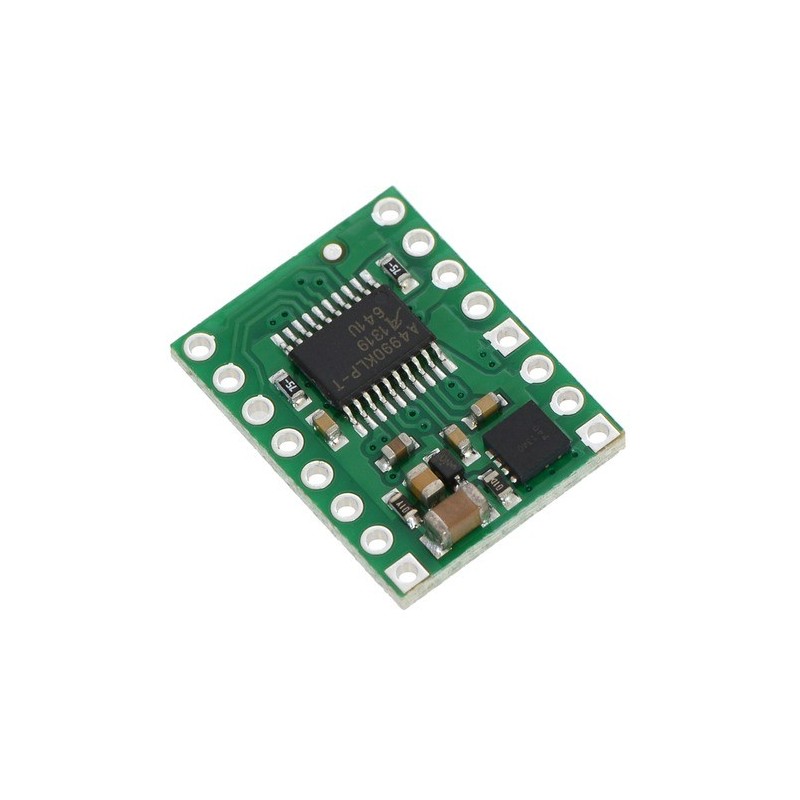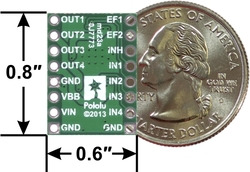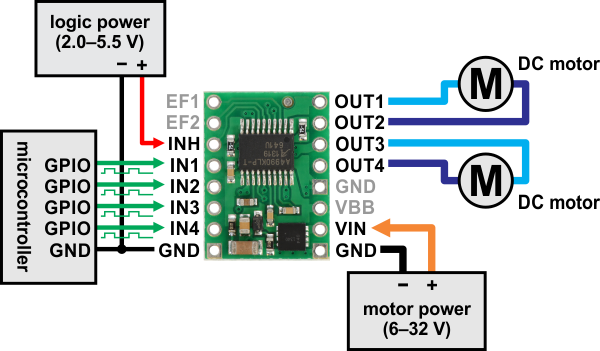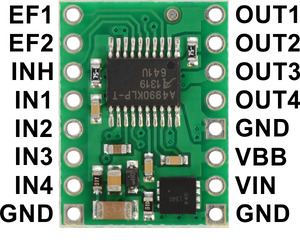

A4990 Dual Motor Driver Carrier
This compact breakout board makes it easy to use Allegro’s A4990 dual motor driver, which can control two bidirectional DC motors over a wide operating voltage range of 6 to 32 V. It is capable of delivering a continuous 0.7 A to each motor channel, and onboard sense resistors enable the A4990 to limit the peak motor current to about 0.9 A per channel. The driver also features protection against reverse-voltage, under-voltage, over-voltage, over-current, and over-temperature.
 |
| A4990 dual motor driver carrier, bottom view with dimensions. |
|---|
Allegro’s A4990 is a dual H-bridge motor driver IC that can be used for bidirectional control of two brushed DC motors at 6 to 32 V. It can supply up to 0.7 A continuously to each motor channel, and the current control feature of the A4990 limits the peak motor current to about 0.9 A per channel with the onboard sense resistors, making this a good choice for small, low-current motors that run on relatively high voltages. Since this board is a carrier for the A4990, we recommend careful reading of the A4990 datasheet (301k pdf). The board ships populated with all of its SMD components, including the A4990 and an additional FET for reverse battery protection.
For a single-channel driver with a DIR/PWM interface and a similar operating voltage range, please consider our DRV8801 carrier. For lower-voltage alternatives to the A4990, consider our DRV8833 and DRV8835 dual motor driver carriers.
1 The overvoltage protection typically kicks in at 34 V, but it can trigger at voltages as low as 32 V.
2 While the A4990 can tolerate input voltages as high as 50 V, the reverse-voltage protection MOSFET is only rated for 40 V.
 |
| Minimal wiring diagram for connecting a microcontroller to an A4990 dual motor driver carrier. |
|---|
In a typical application, power connections are made on one side of the board and control connections are made on the other. The INH (inhibit) pin is pulled low internally, disabling the A4990 by default, and must be driven high (2.0–5.5 V) in order to enable the driver.
The OUT1 and OUT2 pins form one motor channel while the OUT3 and OUT4 pins form the other. The state of each output is controlled by a corresponding input (IN1 through IN4); note that IN2 and IN4 are inverted inputs. All four INx pins are pulled to their inactive states by default. See the truth tables in the A4990 datasheet for more information on how the inputs affect the driver outputs.
The EF1 and EF2 pins are open-drain outputs that are driven low by the chip to indicate active faults (the datasheet describes what each combination of EF1 and EF2 means). Otherwise, these pins remain in a floating state, so you will need to connect external pull-up resistors (or use microcontroller inputs with their built-in pull-ups enabled) if you want to monitor fault conditions on the driver.
 |
| PIN | Default State | Description |
|---|---|---|
| VIN | 6–32 V motor power supply connection. | |
| VBB | This pin gives access to the motor power supply after the reverse-voltage protection MOSFET (see the board schematic below). It can be used to supply reverse-protected power to other components in the system. It is generally intended as an output, but it can also be used to supply board power. | |
| GND | Ground connection points for the motor and logic power supplies. The control source and the motor driver must share a common ground. | |
| OUT1 | Motor A output +. | |
| OUT2 | Motor A output â?’. | |
| OUT3 | Motor B output +. | |
| OUT4 | Motor B output â?’. | |
| IN1 | LOW | Control input for OUT1. PWM can be applied to this pin. |
| IN2 | HIGH | Inverted control input for OUT2. PWM can be applied to this pin. |
| IN3 | LOW | Control input for OUT3. PWM can be applied to this pin. |
| IN4 | HIGH | Inverted control input for OUT4. PWM can be applied to this pin. |
| INH | LOW | Logic input that puts the A4990 into a low-power sleep mode when low. |
| EF1 | floating | Error flag output 1: driven low to indicate active fault status; floating otherwise. |
| EF2 | floating | Error flag output 2: driven low to indicate active fault status; floating otherwise. |
The A4990 can actively limit the current through the motors by using a fixed-frequency PWM current regulation (current chopping). This carrier board connects 0.075 Ω resistors to the current sense pins, which sets the current limit to a nominal 1 A per channel. In our tests, the board actually limited the motor current to slightly above 0.9 A.
Even though the driver limits the motor current to about 0.9 A per channel, the chip by itself will overheat at lower currents. For example, in our tests at room temperature with no forced air flow, the chip was able to deliver 0.9 A per channel for approximately 20 s before the chip’s thermal protection kicked in. A continuous current of 0.7 A per channel was sustainable for many minutes without triggering a thermal shutdown. The actual current you can deliver will depend on how well you can keep the motor driver cool. The carrier’s printed circuit board is designed to draw heat out of the motor driver chip, but performance can be improved by adding a heat sink. Our tests were conducted at 100% duty cycle; PWMing the inputs will introduce additional heating proportional to the frequency (unless the A4990 is already PWMing the outputs to limit the current).
This product can get hot enough to burn you long before the chip overheats. Take care when handling this product and other components connected to it.
|
|
Two 1A—8-pin breakaway 0.1" male headers are included with the A4990 motor driver carrier, which can be soldered in to use the driver with perfboards, breadboards, or 0.1" female connectors. (The headers might ship as a single 1A—16 piece that can be broken in half.) When used with these header pins, the board can be oriented with the parts visible, as shown in the right picture above, or with the silkscreen visible, by soldering the headers in from the opposite side. You can also solder your motor leads and other connections directly to the board.
 |
| A4990 Dual Motor Driver Carrier schematic diagram. |
|---|
This schematic is also available as a downloadable pdf (166k pdf).
Data sheet
Manufacturer BTC Korporacja sp. z o. o. Lwowska 5 05-120 Legionowo Poland sprzedaz@kamami.pl 22 767 36 20
Responsible person BTC Korporacja sp. z o. o. Lwowska 5 05-120 Legionowo Poland sprzedaz@kamami.pl 22 767 36 20
A dual-channel BLDC controller capable of controlling two motors simultaneously using precise FOC vector control. Equipped with the EG Driver Chip, an INA181A2 amplifier, and a 1 mΩ sensing resistor, it provides accurate current measurement and stable operation at peak currents up to 12 A. It supports a variety of encoders and sensors, and its compatibility with ESP32 modules makes it easy to integrate into projects. Makerbase DUAL FOC PLUS
A compact ESC module designed for BLDC motors, ideal for drones and mobile devices. Equipped with the STSPIN32F0A chip and ultra-low RDS(on) transistors, it provides efficient operation and currents up to 20A. It supports 2S–6S LiPo batteries and offers precise sensorless control thanks to BEMF detection. STMicroelectronics STEVAL-ESC002V1
No product available!
Stepper motor driver that can work with a voltage in the range from 20 to 50 V and a maximum current of 4.2 A. It allows you to configure the microstep in the range from 2 to 128. DM542
DC motor driver with voltage 4.5..28V and maximum continuous current of 2.6A. It has the ability to easily implement the feedback loop and numerous control interfaces. Polol 3142
This BLDC motor controller, based on the Allegro A89301 chip, enables sensorless control over a wide voltage range from 5.5 V to 48 V and phase current up to 11 A without additional cooling. It supports four control modes: analog voltage, PWM signal, pulse frequency, and via an I²C interface with the ability to configure parameters and save settings to EEPROM. The Field-Oriented Control (FOC) algorithm ensures quiet and efficient operation, while built-in protection protects the system against short circuits, reverse polarity, and undervoltage. Pololu 5356
DRV8835 Dual Motor Driver Carrier
A two-channel DC motor controller with an I2C interface. It is powered from 1.8 V to 22 V and can deliver up to 1.6 A per motor. Board with soldered connectors. Pololu 5078
Shield with dual-channel DC motor driver for Arduino. It has an operating voltage from 7 to 30 V and a continuous current of up to 10 A. It can be controlled by a PWM signal or by means of built-in buttons. Cytron SHIELD-MDD10
DC motor driver that allows you to control the movement of two drives using the I2C interface. Board without connectors. Pololu 5038
No product available!
Two axis stepper motor driver expansion board based on the L6470 for STM32 Nucleo
Pololu G2 24v12 High Power is a miniature DC motor controller. Driver\'s power supply: 6.5 ... 30V. Current capacity of the module: 12A. The module has protection against back voltage and overvoltage. Pololu 1365
No product available!
Module with 2-channel driver for DC motors L298P. The board is equipped with a Grove connector and communicates via the I2C interface. Seeed Studio 105020093
Brushless motor driver module (ESC regulator) with current efficiency up to 35 A
Expansion board with L6474 stepper motor driver. It is equipped with a connector compatible with Arduino Uno R3 and STM32 Nucleo. STMicroelectronics X-NUCLEO-IHM01A1
A stepper motor driver for precise control of bipolar motors, offering six microstepping modes (from full to 1/32). It operates within a voltage range of 8.2V to 44V and delivers up to 1.5A per phase without cooling or up to 2.2A with a heatsink/fan, ensuring smooth and stable operation even at high speeds. Compatible with the popular A4988 and DRV8825 drivers, with an integrated regulator and overheating, overload, and short circuit protection, the TB67S581FNG is a reliable and versatile solution for applications requiring precise motion control. Pololu 2989

A4990 Dual Motor Driver Carrier
